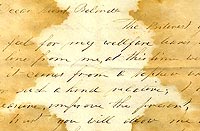
Lesson 6
Writing An Informative Letter
- Time Required: 40 minutes preparation; 30 minutes of writing; 30 minutes of second draft writing (optional)
- Curriculum Fits: History, Geography, Writing
Lesson Overview
This culminating lesson asks students to pull together information from throughout the unit to imagine themselves at sea on a typical whaling bark in the mid 1800s. After looking at several surviving letters from captains to their families, students write a plausible, informative letter to a loved one at home on Martha's Vineyard.
Learning Objectives
- Students will synthesize information learned in previous lessons.
- Students will imagine what it was like to be a whaler on a long voyage.
- Students will write a lively, plausible letter from a whaler to his family.
Materials
- primary source document: transcripts of Captain Colt's letters
- student handout: "At Sea" letter writing assignment
Preparation
Make copies of letters written by Captain Henry Colt to his family and friends on Martha's Vineyard. Each student will need writing materials and assignment instructions.
Procedure
- Pass out the writing assignment "At Sea" and review expectations with the students. Ask students to identify (in a quick-write) three aspects of shipboard life that they, writing as whalers, might describe in a letter home. Refer to the chart from Lesson 4 if this might be helpful.
- After students have brainstormed ideas, discuss the topics and generate categories for information that might be conveyed in a letter. These might include the weather, food, sleeping, quarters, pay, job/chores, location of the ship, information about whales, possessions, other people on board, and references to historical events.
- Now share copies of Henry Colt's letters to family and friends. Take the time to discuss what it would be like to receive one of these letters. What did you learn? What is the most memorable or vivid part of the letter? Why?
- Students may begin drafting at this time or at a later date. Give students an opportunity to share and edit their work so that it becomes more polished. If you wish, publish the letters with or without illustrations.
Assessment
A rubric can be developed by the teacher to assess the student's letters. Student's understanding can also be assessed through observation during class discussion.
Author
Mary Jane Aldrich-Moodie